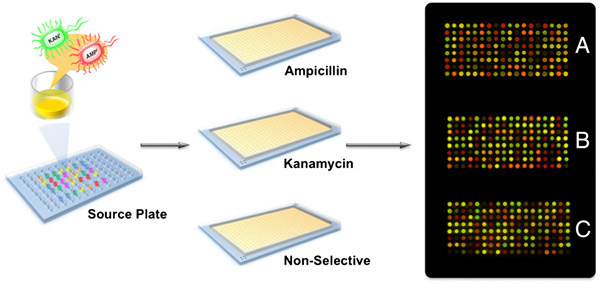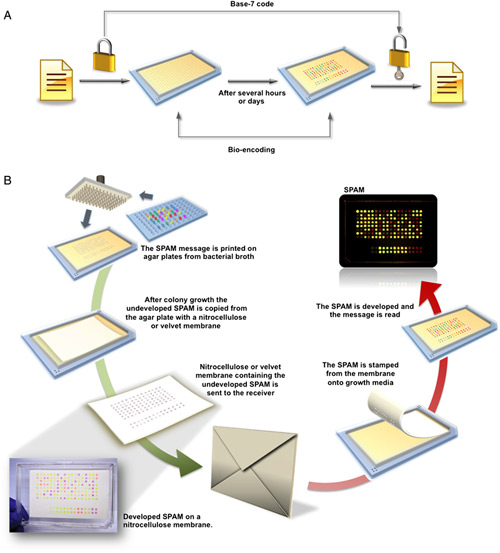Color cipher for recording information in genes

American chemists have invented a method of gene labeling of proteins, so that they begin to glow in one of seven colors in the visible range. Of the seven colors, 49 color pairs are obtained, which is enough for encoding letters, numbers, and other characters. Scientists have demonstrated a new technology on bacteria Escherichia coli.
An additional gene resistant to a specific antibiotic is used to protect the ciphertext. That is, meaningful text from color pairs appears only after the bacteria have been treated with an antibiotic, when “extra” bacteria die. It turns out that the antibiotic plays the role of a key to decrypt the message. A potential attacker will have only one attempt to find the right key.

In this example, the anti-tuberculosis drug kanamycin plays the key for decoding. If the colony is treated with another antibiotic, the message will be irreversibly distorted.
')
This study was funded by order of the military agency DARPA, which is looking for ways to transmit encrypted information without the use of electronic devices. It is difficult to imagine that spies will send each other encrypted letters in the form of bacteria or embed information into the cells of their own body. Although this is probably possible.
For example, the diagram shows the process of transferring an encrypted message to a nitrocellulose membrane, which preserves the “imprint” of proteins and reproduces it in a new bio-solution. This sheet can be sent in an envelope, having previously agreed on the key.

In addition to spy games, the invention has many useful applications. For example, it becomes possible to print "watermarks" on the intellectual property of biotechnological companies, that is, on plants and animals. Copyright can be put on new varieties of wheat or other genetically modified plants with high yields. If the farmer dares to violate the terms of the agreement and after harvesting the grown crop, he sows the grains again (and does not buy a new batch from the corporation), then it will be easily identified with the help of such biological markers.
The inventors are George Whitesides from Harvard University and David Walt from Tufts University in Medford, Massachusetts. The scientific work was published on September 26 in the journal Proceedings of the National Academy of Sciences ( PDF ).
"This is a really cool idea," commented Kenneth Suslick, a chemist at the University of Illinois at Urbana-Champaign. The idea is so cool that it is almost exactly described in the sci-fi thriller Spiral, which came out of print this year, the author of the book - Cornell University physicist Paul McEuen. There, to solve the mysterious puzzle you need to find clues in the form of fluorescent proteins, which are obtained by introducing specific genes into the DNA of various fungi. That is, the main character must find glowing mushrooms. David Walt, one of the authors of a scientific article, says that he did not read the book, but as a science fiction fan, he will definitely read it.
Source: https://habr.com/ru/post/129458/
All Articles